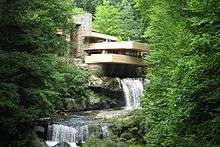Western Pennsylvania Conservancy
The Western Pennsylvania Conservancy (WPC) is a private nonprofit conservation organization founded in 1932 and headquartered in Pittsburgh. WPC has contributed land to 12 state parks, conserved more than 252,000 acres (102,000 ha) of natural lands, plants and maintains more than 130 gardens and greening projects in 19 Western Pennsylvania counties and has protected or restored more than 3,000 miles (4,800 km) of rivers and streams.[1] In 1963, Edgar Kaufmann jr. entrusted Frank Lloyd Wright's masterwork Fallingwater to WPC. The house was called the most important building of the 20th century by the American Institute of Architects and recently voted the most important building of the 20th century.
Charity Navigator awarded the Conservancy its highest rating for the seventh consecutive year. Of the thousands of charities the independent evaluator has reviewed, only 2 percent have received as many consecutive four-star ratings.[2]

History
Three years into the Great Depression, ten citizens came together to found a nonprofit conservation organization.[3] The organization’s goal was to alleviate widespread unemployment through public works programs that would also create a positive impact on the region’s natural resources. Formerly known as the Greater Pittsburgh Parks Association, WPC began its work landscaping a park along Pittsburgh's Bigelow Boulevard.[4]
Land and water conservation
The Conservancy’s work enables protection of important natural resources and creates economic benefits through an area’s tourism, recreation and forestry. Most of the land preserved by WPC is now publicly owned, being some of Pennsylvania's premier parks, forests, game lands and natural areas, or subject to conservation easements that allow public access.[5] WPC acquired land for the creation of 12 state parks, including:
- Ohiopyle State Park, including Ferncliff Peninsula National Natural Landmark
- Laurel Ridge State Park
- Oil Creek State Park
- McConnell's Mill State Park
- Moraine State Park
- Erie Bluffs State Park
- Canoe Creek
- Cook Forest
- Shawnee
- Raccoon Creek
- Clear Creek
- Blue Knob
The Conservancy also includes a Watershed Conservation Program,[6] which focuses on in-stream monitoring and assessment, stream restoration and habitat improvement, abandoned mine drainage remediation, riparian buffer plantings, agricultural best management practices and other projects and surveys.
Gardens and greenspaces
WPC's Community Gardens and Greenspaces Program and its more than 12,600 volunteers plant a quarter of a million flowers and 130 community gardens every spring in 20 western Pennsylvania counties.[7] A partnership of WPC, the Grable Foundation and Pittsburgh Public Schools, brought sustainable landscape to 57 Pittsburgh public schools.[8] The project has provided outdoor classrooms, natural play spaces and low-care plantings to provide shade, landscape accents and natural points of interest for children.
WPC is also the managing partner of TreeVitalize Pittsburgh, which has planted more than 20,000 trees since 2008 in an effort to improve the quality of life and the environment in the Pittsburgh region.[9]
Biodiversity Conservation
The Pennsylvania Natural Heritage Program is a partnership of the Pennsylvania Department of Conservation and Natural Resources (DCNR), the Western Pennsylvania Conservancy, the Pennsylvania Game Commission (PGC) and the Pennsylvania Fish and Boat Commission (PFBC).[10]
The Natural Heritage staff at the Conservancy are responsible for the inventory and monitoring of threatened and endangered species of (both state and federal) and natural communities; maintenance of the Pennsylvania Natural Diversity Inventory (PNDI) database,[11] which contains records for threatened, endangered and other listed species and communities; and provision of conservation services to various entities in the Commonwealth. You can view a list of PNHP’s projects here.
Fallingwater
The Frank Lloyd Wright-designed Fallingwater house, perched over the Bear Run waterfall at Mill Run, is an internationally renowned architectural landmark. Fallingwater was entrusted to the Conservancy by Edgar Kaufmann jr. in Oct., 1963.[12] Included with this gift was the 1,543 acres of surrounding land known as Bear Run, now expanded to more than 5,000 acres.[13] The Kaufmanns became acquainted with the Conservancy when they were involved with the early acquisition of Ferncliff Peninsula, later to become the cornerstone of Ohiopyle State Park.[14]
The donation was received under a deed of trust that requires the Conservancy to preserve and maintain the buildings. In 2013, more than 160,000 people visited the house and grounds of Fallingwater, and Fallingwater’s total visitation has surpassed five million guests since it opened to the public in 1964.
Public tours are offered.[15]
See also
- Pennsylvania Historical and Museum Commission
- Pennsylvania Natural Heritage Program
- List of Pennsylvania state parks
- Conservation
- Architectural conservation
References
- ↑ Western Pennsylvania Conservancy. "About WPC".
- ↑ Charity Navigator. "Western Pennsylvania Conservancy".
- ↑ http://waterlandlife.org/4/history/
- ↑ http://waterlandlife.org/5/
- ↑ http://waterlandlife.org/292/wpc-properties
- ↑ http://waterlandlife.org/112/conserving-water
- ↑ http://waterlandlife.org/36/gardens-and-greenspace
- ↑ http://www.paconserve.org/237/school-greening
- ↑ http://www.apps.dcnr.state.pa.us/news/resource/res2013/13-1113-treevitalize.aspx
- ↑ http://www.naturalheritage.state.pa.us/About_PNHP.aspx
- ↑ http://www.gis.dcnr.state.pa.us/hgis-er/PNDI_Introduction.aspx/
- ↑ http://fallingwater.org/38/fallingwater-facts
- ↑ http://waterlandlife.org/163/
- ↑ http://www.post-gazette.com/news/portfolio/2013/10/27/Kaufmann-makes-a-gift-of-parents-Fallingwater/stories/201310270055
- ↑ http://www.fallingwater.org/82/tours-and-tickets
External links
- official Western Pennsylvania Conservancy website
- official Fallingwater website
- Finding aid to the Western Pennsylvania Conservancy Records at the Archives Service Center, University of Pittsburgh
Coordinates: 40°27′51.73″N 79°58′37.10″W / 40.4643694°N 79.9769722°W